Le Corbusier, born Charles-Édouard Jeanneret-Gris (1887–1965), was one of the most important architects of the 20th century. His innovative designs, modern ideas, and urban planning concepts changed architecture forever. Many call him the “father of modern architecture.” His work still inspires architects, designers, and city planners today.
In this blog, we’ll explore his life, famous works, architectural philosophy, and lasting legacy.
Early Life and Influences
Le Corbusier was born on October 6, 1887, in La Chaux-de-Fonds, Switzerland. He studied art and design, but his passion led him to architecture. His travels across Europe exposed him to different styles, including classical, Gothic, and Renaissance architecture.
Key influences on his work:
- The Industrial Revolution – He admired machines and believed buildings should be as efficient as machines.
- Modern Art – Movements like Cubism and Purism influenced his use of simple geometric shapes.
- Nature – He believed architecture should work in harmony with nature.
Architectural Philosophy
Le Corbusier focused on functionality, simplicity, and innovation. His most famous ideas include:
The Five Points of Architecture:
- Pilotis – Raising buildings on columns to create open space underneath.
- Flat Roof Terrace – Using roofs as gardens or recreational areas.
- Open Floor Plan – Flexible interiors without unnecessary walls.
- Ribbon Windows – Long horizontal windows for better light and ventilation.
- Free Facade – Exterior walls that don’t support the building, allowing creative designs.
The Modulor System
Le Corbusier developed a measurement system based on human proportions to create comfortable and beautiful spaces.
Urban Planning
He designed cities with organized layouts, green spaces, and efficient transport. His “Radiant City” (Ville Radieuse) idea proposed high-rise buildings surrounded by parks.
Iconic Works
Le Corbusier designed many famous buildings. Here are some of his most important works:
1. Villa Savoye (1928–1931)
- Located in France, this house is a perfect example of his Five Points of Architecture.
- It features open space, pilotis, and ribbon windows.
2. Unité d’Habitation (1947–1952)
- A residential complex in Marseille, France.
- Designed as a “vertical garden city” with communal spaces and rooftop gardens.
3. Chandigarh City (1950s)
- He designed the Indian city of Chandigarh, including government buildings like the High Court and Secretariat.
4. Notre-Dame-du-Haut (1950–1955)
- A chapel in France known for its curved walls and natural lighting, different from his usual geometric style.
Legacy and Influence
Le Corbusier’s ideas shaped modern architecture and urban planning. His influence can be seen in:
- Modernist Architecture – His clean lines and functional designs inspired many architects.
- City Planning – His ideas about zoning, green spaces, and efficient transportation are still used today.
- UNESCO World Heritage Sites – In 2016, 17 of his works were recognized as UNESCO World Heritage Sites.
Criticism and Controversy
While many admire Le Corbusier, some criticize his work for being too rigid. His city planning ideas sometimes ignored cultural and social needs. He was also linked to controversial political views.
Conclusion
Le Corbusier changed the world of architecture with his innovative ideas and designs. His works, like Villa Savoye and Chandigarh, continue to influence modern architecture and city planning.
What’s your favorite Le Corbusier design? Share your thoughts in the comments!

